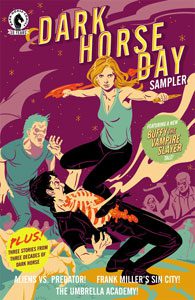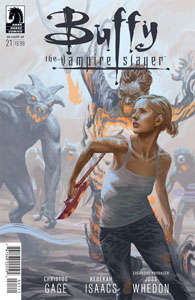Season 10 started with Buffy and the gang being modest about their callings, and it ends with them realizing the mature response is to embrace their callings, because the world will be worse off they don’t. Too many bad actors will seek to fill the power vacuum. It’s a pretty great way to dig into the theme of adult responsibility, and not exactly like what we’ve seen before.
The problem with the season is the way the story is told; it’s too decompressed, and the “Vampyr” book – while a good macro idea – doesn’t provide good drama from issue to issue. I also take issue with the rote presentation of some of the character arcs. For example, Buffy and Spike’s drama plays out entirely through their conversations, and therefore isn’t all that dramatic. It is quite adult, though, I’ll give that to writer Christos Gage.
And I like that everyone is in a good spot at season’s end: Buffy and Spike aiming for an adult relationship, Xander and Dawn having a good shot at making it work the second time around, Giles and Willow with purpose on the Magic Council, and Andrew proving himself once and for all as a reliable member of the team.
“In Pieces on the Ground” (Issues 21-25, November 2015-March 2016)
This five-parter feels like the last of the long streak of mediocre “Buffy” arcs. In and of itself, it’s not great, but it does finally add stakes to the proceedings to be addressed in the season finale. Dawn and Xander are left in a hell dimension (as Dawn’s Key powers are the only way to close the portal and save Earth, and I guess they only work on that side of the portal). Meanwhile, D’Hoffryn kills the Soul Glutton and the Siren Mistress and resolves to steal the “Vampyr” book from Buffy.
Before we get to that point, Gage engages in the now-standard boatload of theorizing and explanations about how the portals work, and peppers in low-grade (compared to some past seasons) internal conflict. The most interesting is the philosophical clash between Buffy and Willow in regard to working with the U.S. military, which killed Slayers in Season 8. Buffy is reluctant to work with the military now, because it is the same organization. Willow is willing to work with it, because it has been purged of all its members from Season 8.
This is an age-old conflict in political circles: Should a government (or governmental branch) be judged on its actions, or should it be viewed as an entity that will inevitably exist, and therefore be judged by what its current members are doing or trying to do? There are merits to both arguments, and “In Pieces on the Ground” illustrates both sides. My instinct is to side with Buffy, but Willow’s logic is sharp, too – even if she is somewhat influenced by her girlfriend, military member Lake (who I completely forgot about from my first reading).

“In Pieces on the Ground” does include a rare piece of Joss Whedon-style subverting-the-cliché writing from Gage. In Issue 23, Andrew seems like he will backslide and accept the Sculptor’s offer to resurrect Jonathan if Andrew steals the Scythe from Buffy. Andrew shows up at the meeting place, but with the whole Scooby Gang in tow, ready to take down the Sculptor: Andrew does the right thing, and it’s a genuine moment of growth.
Other than that moment, this arc is inoffensively flat. In Issue 21, Buffy and Spike for some reason must defeat monsters in a fighting ring in order to secure a truce between humanity, old-school vampires and New Rules vampires. Satsu visits Buffy in this issue to make a pitch for her to team up with the military, but then in Issue 22 Buffy is blindsided by Willow accepting a similar pitch, an example of Season 10’s tendency toward choppy narrative flow.
Another element that has me looking forward to the season’s final arc is the faux version of Anya. This ghost that has been hanging around Xander all season has gained a body and vengeance-demon powers. Multiple supernatural sources have told Xander and Faux Anya that she’s not really Anya, so I don’t think that is supposed to be a mystery. But it does leave the question of “Who the heck is she?”
3 stars

“Own It” (Issues 26-30, April-August 2016)
Season 10 probably didn’t have to be 30 issues, and even the last arc probably didn’t have to be five issues. Still, this is a strong conclusion to a weak season, as D’Hoffryn emerges as an unambiguous Big Bad in clever fashion and the Scoobies defeat him in a grand finale that has meaning for all the characters and has something to say about political power and how to counter it.
Earlier in the season, Buffy and Willow saw the sharing of powers over what gets written in the “Vampyr” book as the decent and democratic approach, but in “Own It” they realize they were scared of the responsibility. D’Hoffryn capitalizes on that; he kills all the other members of the Magic Council, then takes power under the clause that “Should a council member be rendered unable to discharge their duties, the responsibilities will be divided among the remaining members.” It’s a nice metaphor for how well-meaning Constitutions can be subverted by someone bound and determined to do so, especially if they have no opposition, or only pseudo-opposition.
“You were tricking us into doing what you wanted,” Buffy realizes in Issue 27. “And you complied like dull-witted sheep,” D’Hoffryn replies before delivering one of those zingers he’s surprisingly good at: “If only you’d known I was a soulless demon whose reason for being is revenge. … Oh, wait. You did.”
It takes too long to get to the final showdown, as Issue 28 is entirely about Buffy deciding to stay with Spike even as their relationship gets tough. But then we get the twist: If lots of people believe D’Hoffryn doesn’t have power, then he doesn’t. Buffy spreads the word, and the strategy works. As D’Hoffryn writes his desired powers into “Vampyr,” the book spits the ink back in his face. It’s a nice metaphor for how mass revolution is always an option against unjust (even if legal) laws and leaders, and it can even be fairly bloodless if the numbers are overwhelming enough.
D’Hoffryn has one last gambit: to flat-out kill Buffy and friends. Issue 30 nicely mixes that fight with character beats for everyone, and culminates with a wonderful epilogue of everyone at game night, having a good time but owning their responsibility to be wise leaders in this newly magic-seeded world.
A cliffhanger from the previous arc was “Who is the faux Anya?” and the answer isn’t all that clever: She’s a being artificially created by D’Hoffryn. But the usage of the character is excellent. Faux Anya – after a nice Issue 29 cliffhanger where it seems she has killed Xander — recognizes her boss’s evilness and turns on him, ultimately becoming her own person even though she was artificially created.
Probably not coincidentally, Dawn goes through this too. Armed with Key powers, she and Xander venture through alternate dimensions and eventually return to Earth. We saw Willow on a similar trek in Season 9’s “Willow: Wonderland,” but Gage does something different here by aiming for the funny side. Xander teaches one demon race about the benefits of slanted roofs, and as the dimensional stops get pared down to single panels and get weirder, the duo eventually visits the dimension of shrimp that Anya mentions in “Superstar” (4.17). I’m on the fence about whether a journey through hell dimensions should be comedic, but the punchlines are delivered well enough that I’ll allow it.
4 stars

“Where Are They Now?” (Dark Horse Day Sampler, June 2016)
Season 10 has only one side story, and while eight pages isn’t enough for a meaty tale, there are fun eight-pagers and boring eight-pagers. “Where Are They Now?” leans toward fun. It’s not the funniest Harmony story ever, but if you aren’t tired of her, it’s a decent one. Film crew in tow, the self-centered vampire keeps ambushing Buffy for an interview, making tactless observations about her aging, her tendency to date vampires, and her boringness now that there are thousands of Slayers.
Harmony ultimately asks a question that might get to the thematic heart of a saga where the world is so often at stake, something it seems did not happen before Buffy became the Slayer (although possibly previous Slayers just aren’t as well-chronicled): Is Buffy the best Slayer ever, or the worst?
The Dark Horse Day Sampler also includes reprints of classic “Aliens vs. Predator” and “Sin City” stories – not a bad entry point for getting into those sagas … except that I’m still on this Buffyverse kick.
3.5 stars
Click here for an index of all of John’s “Buffy” and “Angel” reviews.

